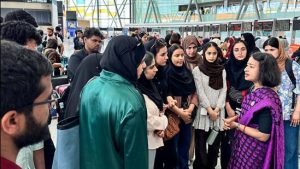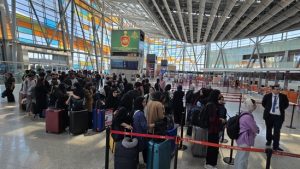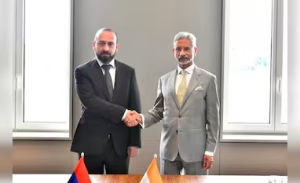New Delhi – The first flight under Operation Sindhu successfully landed in Delhi during the early hours of Thursday, marking a significant milestone in India’s evacuation efforts amid the escalating Iran-Israel conflict. This inaugural evacuation flight carried over 100 Indian students who had been moved from Iran to Armenia through carefully coordinated arrangements by the Indian government.
The first flight under Operation Sindhu represents the culmination of swift diplomatic efforts and logistical coordination between Indian authorities and regional partners. The operation demonstrates India’s commitment to protecting its citizens abroad during times of international crisis and conflict.
Successful Border Crossing and Evacuation Details

A total of 110 Indian students successfully crossed the border from Tehran to Armenia through meticulously planned arrangements made by the Indian Embassy under Operation Sindhu. The first flight under Operation Sindhu carried these students to safety after they traversed the challenging journey from Iran’s capital to Armenia’s borders.
The evacuation process involved multiple stages of coordination, with the first flight under Operation Sindhu serving as the primary vehicle for bringing these students back to Indian soil. The operation required extensive planning between diplomatic missions, transportation authorities, and safety personnel to ensure the secure passage of all evacuees.
Ministry of External Affairs Coordinates Swift Response
The Ministry of External Affairs issued a comprehensive statement on Tuesday outlining the evacuation procedures and safety measures implemented under Operation Sindhu. The first flight under Operation Sindhu was preceded by careful movement of Indian students out of Tehran for safety reasons through arrangements facilitated by the Indian Embassy.
/newsdrum-in/media/media_files/2025/03/07/yWeuK1bIhqsyLn4kjpg1.png)
/newsdrum-in/media/media_files/2025/03/07/yWeuK1bIhqsyLn4kjpg1.png)
According to official communications, the first flight under Operation Sindhu was part of broader evacuation efforts that also included advisory services for other Indian residents in Iran. The Ministry advised self-sufficient individuals regarding transportation options to move out of Tehran, given the developing security situation in the region.
The first flight under Operation Sindhu exemplified the government’s proactive approach to citizen safety, with officials indicating that additional advisories might be issued depending on the evolving circumstances in the conflict zone.
Student Demographics and University Affiliations


The Jammu and Kashmir Students Association confirmed that the first flight under Operation Sindhu transported 110 Indian students from Urmia Medical University, with 90 of these students originating from the Kashmir Valley. This demographic breakdown highlights the significant impact of the evacuation on students from specific regions of India.
The first flight under Operation Sindhu provided relief to families across India, particularly those in Kashmir who had been anxiously monitoring the deteriorating security situation in Iran. These medical students had been pursuing their MBBS degrees at Iranian institutions when the conflict escalated.
Family Gratitude and Government Appreciation
Haider Ali, father of 21-year-old Maaz Haider, an MBBS student in Iran, expressed profound gratitude for the government’s rescue efforts. He acknowledged the significance of the first flight under Operation Sindhu in bringing students back home safely, while also expressing concern for those still stranded in Tehran.
The Jammu and Kashmir Students’ Association extended thanks to Prime Minister Narendra Modi and External Affairs Minister S Jaishankar for launching the evacuation effort. They recognized the first flight under Operation Sindhu as a testament to the government’s commitment to student welfare and safety.
The association expressed hope that the success of the first flight under Operation Sindhu would pave the way for additional evacuation flights to rescue remaining students still in Iran.
Student Testimonials Reveal Ground Reality
Mir Khalif, an MBBS student who arrived on the first flight under Operation Sindhu, provided firsthand accounts of the tense situation in Iran. His testimony revealed the serious security concerns that necessitated the evacuation operation, including missile sightings and bombing in residential neighborhoods.
Khalif described witnessing active warfare and bombardment in their vicinity, creating an atmosphere of fear and uncertainty among the student community. The first flight under Operation Sindhu provided these students with their first sense of safety after experiencing the traumatic effects of armed conflict.
He emphasized gratitude for the government’s decision to first evacuate students to Armenia before arranging the first flight under Operation Sindhu to bring them home to India.
Ongoing Evacuation Efforts and Future Plans


While celebrating the success of the first flight under Operation Sindhu, officials and families remain focused on evacuation efforts for students still in Iran. The government has reportedly relocated remaining students to safer locations within Iran while planning additional evacuation measures.
The first flight under Operation Sindhu establishes a precedent for future evacuation operations, demonstrating the feasibility of the Armenia route for bringing Indian students home safely. Officials continue monitoring the situation to determine when additional flights might be necessary.
Students and families express confidence that the success of the first flight under Operation Sindhu will encourage authorities to expedite evacuation efforts for those still awaiting rescue from the conflict zone.
Strategic Importance of Operation Sindhu

The first flight under Operation Sindhu represents more than just an evacuation; it demonstrates India’s diplomatic capabilities and crisis management expertise. The operation required coordination across multiple government departments, diplomatic missions, and international partners to ensure successful execution.
This evacuation mission showcases India’s commitment to protecting its citizens abroad, regardless of the complexity of international situations or geographical challenges involved in rescue operations.

